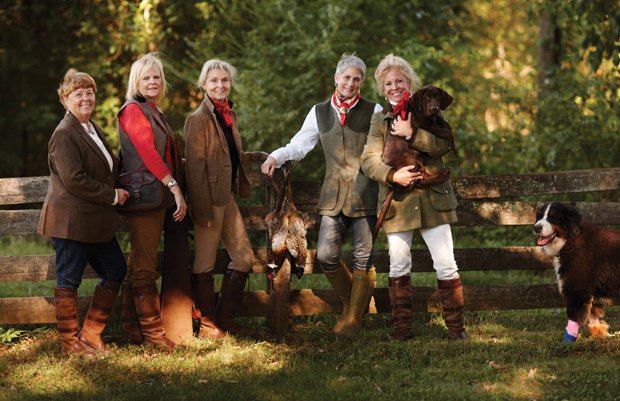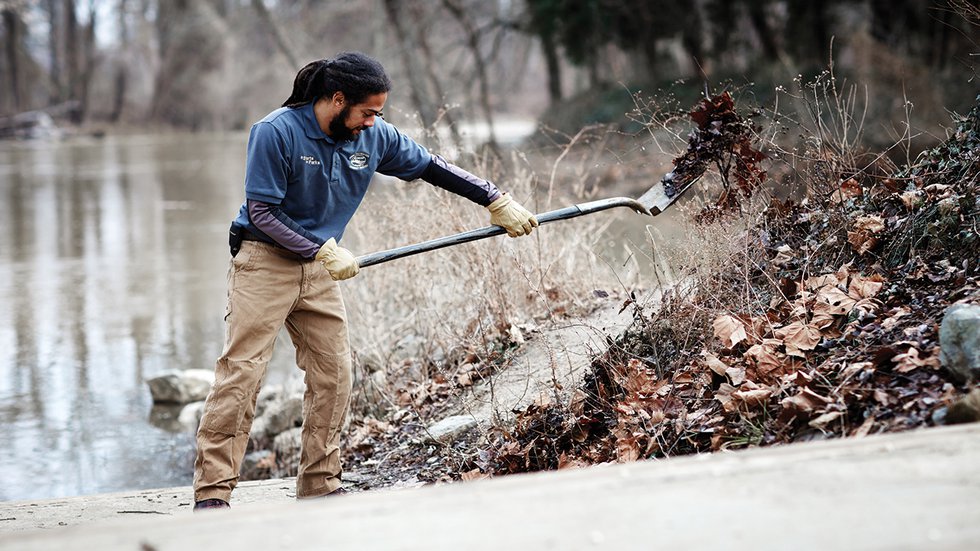It’s barely dawn when I pull into Dutch Gap Conservation Area—part of Henricus Historical Park, south of Richmond in Chesterfield County. Already, a few people are milling about in the parking lot, whispering in clumps of two or three.
I’d expected a legion of retirees dressed in mid-calf black socks, cargo shorts, khaki vests, with binoculars the size of sub sandwiches—in birder slang, they’re “bins”—hanging from their necks. Instead, it’s pink highlights, tank tops, and tattoos.




I’ve come to witness an old-school hobby that’s gone oddly hip, embraced by a new generation. Author Michael Chabon is a bird-watching fanatic, as is book critic Alex Preston, who’s in his mid-thirties. “You can never stop seeing birds once you’ve become a birdwatcher,” he says. For Preston, the peak moment comes, “when the heart and bird are one. I think many people come back to birding as a way to define themselves as we move to middle age.”
At 25, I’m not there yet. But I am on the prowl for my spark bird. Like your first kiss, your first bird goes on your permanent record—like it or not. Ask any birder; they’ll know the date, place, time, temperature, and what they ate for breakfast, on the day they saw their spark bird.
At the stroke of seven, a guy wearing a Brews & Dudes t-shirt and Ray Bans steps forward. He’s our guide, Wes. “Alright folks,” he announces. “Today we’re gonna find some shorebirds, hopefully.” He looks to be 30, but it’s hard to know; much of his face is concealed by a full hipster beard, roomy enough to stash car keys and a wallet.
Shorebirds can be anything from sandpipers to seagulls. And with gulls, you’ve got endless variations, from black-backed, to herring, and laughing—as any self-respecting birder will tell you. The park trail weaves around a lake, so shorebirds should be plentiful. The air feels electric as we head out, a tinge of sunlight starting to warm us.
Someone spots a mourning dove and I feel smug about missing one of the avian kingdom’s stupidest birds—or so someone mutters. But it’s a “mega-find” for the woman in yellow shorts, a tan hat, and frizzy hair a few paces ahead of me. You’d think a rare toucan had turned up on the Atlantic seaboard, she’s so excited. We spend 10 minutes trying to spot it, calling out “Over there!” and “By that tree!” and “Yeah, left!” before we give up. I learn later that real birders use clock face terminology to bypass this occupational hazard: Oak tree. Third branch. Two o’clock. Got it.
Birdwatching offers a good excuse to get a lungful of clean air. The Audubon Society helpfully notes that being outdoors lowers our stress hormones, blood pressure, heart rate. I’m sure this is true, but at the moment, I’m riddled with anxiety about my first feathered find—not to mention a bit impatient to spot a rare one.
Finally, my “spark” comes at 7:24 a.m. I check my watch to confirm this. Is it a sparrow? A hawk? Perhaps a bluebird? No such luck. It’s a Canada goose, the hobo of the American office park. Birders call them “lawn carp,” the guy beside me explains, adding, “they just migrated down here and never left.”
You don’t need binoculars to spot a Canada goose, but I’ve borrowed my grandfather’s for this morning’s excursion. “Used by Navy Seals,” he assured me, solemnly. As people around me compare scope numbers, I wonder if the Navy procured these from Toys “R” Us. They’re only useful for spotting the dragonflies hovering above tall grass nearby which, I quickly deduce, correlate directly to bug bites—whether you’re wearing socks and boots, as I am, or not.
I rustle a bush as I pass by it, and a dozen bins lock on the spot. Birdwatching, I notice, makes otherwise laid-back types turn excitable. As we scrutinize each tiny leaf, I wonder how many birds are watching us from down the path and rolling their beady eyes.
Some people carry guidebooks, but many rely on Wes or their fellow birders to confirm sightings. “It’s great to see people joining in that weren’t aware of this before,” says a young woman next to me, who introduces herself as Suleka Deevi. “I’ve always liked birds since I was a kid.” Now a professional guide, she also happens to be a vice president of the Richmond Audubon Society. Birding, “brings people together,” she tells me, “and it gives people a connection with nature through birds. I don’t know of any other group that is as helpful and friendly.”
Someone calls out a sighting, so we raise our bins and smile in silence. “In the fall,” she whispers, picking up the thread after a few beats, “birds are migrating south, so you see a lot of different species. But I get super excited when it’s springtime because I love hearing the constant birdsong. Mating season, you know.”
Gender is crucial with birds, our guide tells us. I thought we’d all gotten past that but, in the bird world, the males are the beauties who, in an oddly satisfying switcheroo, wind up being objectified. Female birds are dull by design, blending into their surroundings to survive. I suggest that female sightings should earn extra bragging rights, but I couldn’t get anyone on board with the idea.



Like rush hour in the city, after 40 minutes of stop and go, we’ve traveled maybe 100 feet. I’m antsy to get a move on; it’s two or three miles to circumnavigate the whole lake. But I take a breath and attempt to focus on the here and now. Birding, I’m told, is meditative. Frankly, right now, meditating is all I can do.
When someone sights a “pretty chunky warbler,” the group lurches toward it like a gold rush, only silent, so the bird doesn’t scare and scamper. And a few minutes later, when I’m rewarded with a close-up of a kestrel preening on a dead tree, I’ll admit, it’s magic. We are both in the same space, yet it remains unaware, or simply unperturbed. We are enamored; the bird is content simply to be.
For birders, documenting sightings with lists and figures is part of the fun. How many have you spotted? Where? Which ones are you hoping to spot today? This month? This year? A “twitcher” takes this list-making to obsessive heights, rattling off species and dates like middle-schoolers reciting a poem in class.
Another 15 minutes of standing and we’re off again, our guide moving faster now. Then a “dude”—a birder term for an amateur, the guy who thinks penguins can fly—points and bobs his bins about. But it’s a false alarm. We spend 15 minutes trying to locate his “not-a-bird.” These avian Where’s Waldos seem to bother no one but me.
On this particular morning, the false alarms are more plentiful than the birds. Instead of stops and starts, I’d imagined a breezy stroll around a lake. Granted, it’s bird watching, not bird walking. Maybe I’m not hip enough, or I lack the necessary patience, but give me a brisk hike under a blue sky any day. If I see a bird along the way, all the better. Where I’m feeling spurned by the birds I’m not adding to my list, others feel amorously intoxicated by the search itself.
Perhaps I’m a window shopper, like my grandfather, who watches his bird feeder through the glass. It takes a certain temperament to remain perpetually vigilant on a lakefront trail or in a forest. I read once that Vladamir Nabokov, obsessed with butterflies, could wait for them in stillness for hours. With two miles to go, I realize I’m no Nabokov. I tap out with Wes, who consults a park map to point me and a pair of older ladies—who look like they wandered into the wrong classroom—back to the parking lot.
There are an estimated 45 million birders in the U.S. You can count yourself among them if you’ve taken “a trip of one mile or more for the sole purpose of observing birds,” according to Audubon. Now that I’m officially a birder with an office-park goose as my spark, it’s true, my eyes have been opened. We’ve all made assumptions, and this crowd, who politely ignored my Toys R Us binoculars, reminds me that you never really know a birder until you’ve walked a mile around their lake.
Eye Spy
Everyone and their uncle can recognize a cardinal or a robin, but which feathered flyers remain elusive, even to expert eyes? For Suleka Deevi, of the Audubon Society’s Richmond chapter, it comes down to habitat. “It used to be super common to see a woodthrush, but since their numbers have declined, not so much.” In spring, juvenile birds can be difficult to identify because their plumage and shape are still changing.
Last year, in Eastern Virginia, the Northern gannet turned up in 12,000 recorded sightings through The Great Backyard Bird Count’s eBird app. And the Shenandoah’s common grackle earned over 15,000 hits. Despite these numbers, bird populations have declined by as many as three billion since the 1970s, according to a large-scale 2019 study reported in the journal Science.
Audubon has identified 604 at-risk bird species, determined from data distilled from 140 million observations detailed by birders and scientists. We hear about the bald eagle or sandhill crane populations, but less flashy species like the house sparrow are also in jeopardy. These birds are valuable pollinators, and they play an essential role in the food chain.
Where to Go?
The Audubon Society Start here for a fountain of bird facts, tips on spotting them. Each of their 450 chapters, which host local birdwatching meetups, are listed here. Audubon also publishes field guides and has a downloadable phone app, too. Audubon.com
Birding Virginia: A resource for specific pointers on birding in the Commonwealth. BirdingVirginia.org
Virginia Bird and Wildlife Trail: The best nature trails, mountain routes, or rivers, to see birds —from brown pelicans along the Atlantic Coast to ravens in the Appalachians.
Meetup App: Local Audubon chapters typically post upcoming field-trips and excursions here. Members and non-members are welcome and Meetup lets you register in advance. Meetup.com
Birder Slang
Birders—also known as “twitchers”—have their shorthand language, with “dialect” variations between countries or regions. To speak like a birder, study up here:
BOP: a bird of prey
Butter Butts: yellow-rumped warbler
Dip: a rare bird missed
Nemesis Bird: a coveted bird that remains elusive
Jinx Bird: a fairly common bird that eludes you
Jungle Fowl: chickens
Patch: a birdwatching area
Tick: adding a new bird to your list of birds spotted
Twitcher: a committed birdwatcher who chases after rare birds, often traveling long distances
Yabow: a non-birder, possibly with a dog, who scares off the birds









